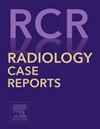右冠状动脉异常起源地肺动脉伴右冠状动脉至左前降支瘘1例
Q4 Medicine
引用次数: 0
摘要
75岁女性患者,有动脉高血压病史,表现为压迫性胸痛放射至左上肢,轻度用力时伴有呼吸困难。心电图无明显变化,但心脏生物标志物阳性提示接受中间护理和冠状动脉造影。结果包括一条起源于肺动脉干并向右房室沟延伸的小口径血管,左前降支与右冠状动脉之间的动静脉瘘流入肺动脉,冠状动脉明显偷取,心外膜冠状动脉无狭窄病变,左心室收缩功能保留。冠状动脉CT血管造影显示冠状动脉钙评分高(5339 Agatston),右冠状动脉起源于肺动脉异常(ARCAPA),弥漫性冠状动脉扩张(Markis I),弥漫性非阻塞性冠状动脉粥样硬化疾病(CAD-RADS N)。心导管检查确认收缩期功能保留(LVEF 65%),心内压和肺阻力正常,但Qp/Qs比为1.25。双侧肺动脉造影未见明显阻塞。解剖和血流动力学结果在多学科医学会议上与介入心脏病专家,心脏病专家和心血管外科医生讨论,导致手术干预的决定。本文章由计算机程序翻译,如有差异,请以英文原文为准。
Anomalous origin of the right coronary artery from the pulmonary artery with a right coronary artery to left anterior descending artery fistula: A case report
A 75-year-old female patient with a history of arterial hypertension presented with oppressive chest pain radiating to the left upper limb, accompanied by dyspnea on mild exertion. Electrocardiogram showed no significant changes, but positive cardiac biomarkers prompted admission to intermediate care and coronary angiography. Findings included a small-caliber vessel originating from the pulmonary artery trunk and extending toward the right atrioventricular groove, an arteriovenous fistula between the left anterior descending artery and the right coronary artery draining into the pulmonary artery, with significant coronary steal, no stenotic lesions in the epicardial coronaries, and preserved left ventricular systolic function. Coronary CT angiography revealed a high coronary calcium score (5339 Agatston), anomalous origin of the right coronary artery from the pulmonary artery (ARCAPA), diffuse coronary dilatation (Markis I), and diffuse nonobstructive coronary atherosclerotic disease (CAD-RADS N). Cardiac catheterization confirmed preserved systolic function (LVEF 65%), with normal intracardiac pressures and pulmonary resistances but with a Qp/Qs ratio of 1.25. Bilateral pulmonary arteriography showed no significant obstructions. Anatomical and hemodynamic findings were discussed in a multidisciplinary medical meeting with an interventional cardiologist, cardiologist, and cardiovascular surgeon, leading to the decision for surgical intervention.
求助全文
通过发布文献求助,成功后即可免费获取论文全文。
去求助
来源期刊

Radiology Case Reports
Medicine-Radiology, Nuclear Medicine and Imaging
CiteScore
1.10
自引率
0.00%
发文量
1074
审稿时长
30 days
期刊介绍:
The content of this journal is exclusively case reports that feature diagnostic imaging. Categories in which case reports can be placed include the musculoskeletal system, spine, central nervous system, head and neck, cardiovascular, chest, gastrointestinal, genitourinary, multisystem, pediatric, emergency, women''s imaging, oncologic, normal variants, medical devices, foreign bodies, interventional radiology, nuclear medicine, molecular imaging, ultrasonography, imaging artifacts, forensic, anthropological, and medical-legal. Articles must be well-documented and include a review of the appropriate literature.
 求助内容:
求助内容: 应助结果提醒方式:
应助结果提醒方式:


